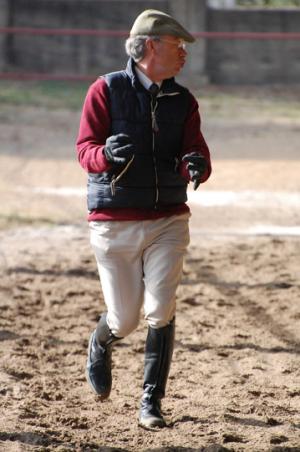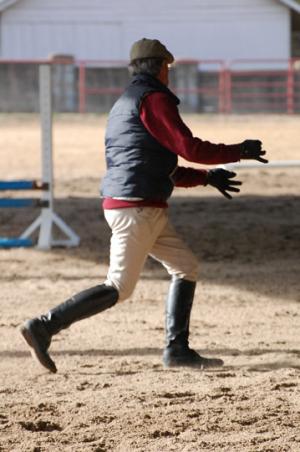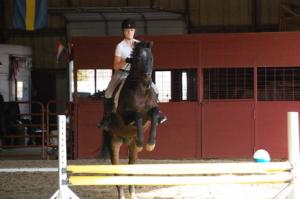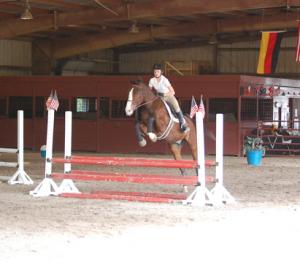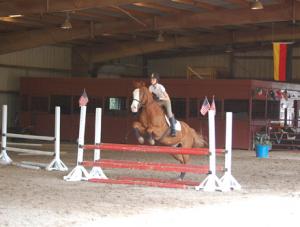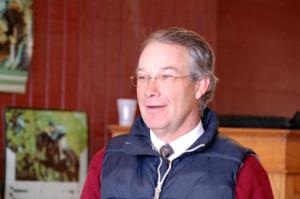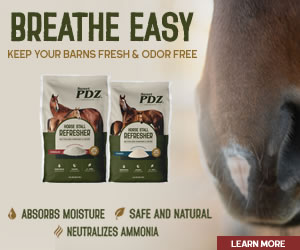Article and photos by Nancy Brannon
McKrell and Christian Baier once again hosted a clinic with international, award-winning show jumper Albert Voorn November 30-December 2, 2012 at their Southern Blues Equestrian Center south of Collierville, Tennessee. Eighteen riders filled the two-day clinic. This time they included a Theory Seminar with Master Saddler Bernardo Vergara, of Verhan Saddlery, Morriston, Florida. Vergara and Verhan Saddlery have developed a unique saddle design that gets the saddle off the horse’s shoulder, allowing greater freedom of movement and greatly reduced discomfort, pain, and resulting physical problems with the horse’s shoulder, which was not designed to carry the weight of the rider. Verhan Saddlery offers Free Shoulder Saddles™ for polo, dressage, and jumping.
Albert Voorn emphasized the consistency and the focus in his teaching that produces good riders. “I work on one thing wherever I go, who ever I am training,” he said. “It’s all about the position of the rider. That’s it! In the exercises I try to make the rider more alert and ready. In show jumping, the fences come quicker and the course requires faster action [and reaction].”
In McKrell’s 20’ X 40’ arena, a course of jumps was set up with oxers and verticals that could be jumped both directions, and turns could easily be made left and right. So the riders were not riding the usual figure-eight course with specified distances, but could “mix and match” jumps to keep them thinking and alert as Albert called out the course to the riders. “The exercises work well for the riders, and at the same time they work the body of the horse intensely. With short turns, the horse has to collect quickly. The more you repeat, the easier it gets for the horse. In the U.S. with amateurs, everything is very slow. So I try to get a little more activity with the horse and the rider.” Because of the slow hunter traditions, Albert wants to get things a little more upbeat. This results in the rider being able to do think more quickly and do the work in an easy way, and for the horse to learn to be more responsive to the aids. In general, he wants riders to slow the reaction; “riders make too much effort to make the horse go forward. I try to reduce the action, so it appears no aid is happening. At the end of the day, the aids should be seamless. Sadly, this is not happening any more, in dressage or show jumping. Judges don’t judge the rider and, consequently, you don’t see stylish riders like Bill Steinkraus.”
For the rider’s aids to be almost invisible to the observer’s eye and to be seamless with the horse is the priority in Voorn’s teaching. He doesn’t see this, not even at the famous Spanish Riding School in Vienna, Austria. “Their legs move backwards, there is too much body effort. A hard working rider disturbs the horse. You want to see the rider’s aids almost invisible. I like to see beautiful riding because it’s done correctly. When done correctly, it’s automatically beautiful,” he said.
Voorn watched a reining class in Lyon, but was disappointed in the fact that the movements didn’t look smooth. “They show off, he commented. “I’m not sure of the purpose [of the rider’s extra movements]. In any equestrian sport you want to see good riding. Wow! Beautiful! Smooth! Harmony! Even in racing you want to see it, for example, Steve Cauthen [Triple Crown winning jockey] had it.” The jockey in Europe Voorn admires is Olivier Peslier, Thoroughbred racing jockey. “His style, leg and body position; he is always soft on the horse. He never gives the horse a rough race, except once!”
“Perfection is very rare to get. But when riders don’t try for perfection, I’m very disappointed. This is highly important. We use/abuse an animal for our pleasure. We owe it to the animal to give him a ride as comfortable as possible. We should disturb him as little as possible. When that is the case, it is automatically nice to watch.
“So I keep trying, although I have lost many battles. I keep doing it because my heart is in it. I will do it until the day I die.”
Voorn is from the Netherlands and was Individual Silver Medalist in Show Jumping at the 2000 Summer Olympics in Sydney, Australia. At his Golden Dream Stables in Evertsoord, a village in Horst aan de Maas, in the province of Limburg, he specializes in training show jumpers and eventers, giving clinics, and instructing riders with their horses at home as well as abroad.
Voorn has a non-stressful approach to improving riding and the horse’s performance. While a renowned successful rider himself, he maintains a modest demeanor, although he strives for perfection and subtlety of aids.
He begins clinics with warm-up on the flat, carefully observing riders and pointing out subtle changes they could make to improve. He has riders do lots of transitions, helping riders make the horse as comfortable as possible. For example, he gives this advice on sitting the trot: “Wait until all is in balance and the stride is slow enough that you can comfortably sit the trot. When the pace is so slow that the rising trot gets difficult, then the stride is slow enough to sit the trot as comfortably as possible.” “You always want to be as comfortable as possible, so adapt your position to the pace you’re in.” This ensures the least discomfort to the horse’s back.
Albert is known to trot or canter around the ring himself, demonstrating what the rider is doing, or what the rider could do to improve. He demonstrated what to do with the leg and body when asking the horse to slow down. “When slowing down, remove the leg pressure. Then you can add leg pressure to go forward again. When you slow down, take a deep breath. You loosen your body, making sure you are not gripping with the knee, or with the calf.”
“Allow the horse to carry his head where he wants,” he advised. “The horse always carries his head where it is most comfortable for him, so there is no point in trying to put his head in a position where it is difficult for him.
“We want to disturb the horse as little as we can. Make the horse comfortable – because the rider, no matter how good he/she is, is always a disturbance to the horse just because the horse has to carry us on his back.”
Responsiveness to the rider’s aids is important. “When you give an aid, the horse must respond,” he said. “When you maintain contact and the horse goes somewhere we don’t want him to go, we can always make adjustments with the rein – on the approach, over the fence, wherever needed. Over the top of the fence, stay off the horse’s neck. If the fence wasn’t what you wanted, don’t worry about it.” His frequent response to riders’ efforts was “Very nice.”
His approach to jumping is uncomplicated. “The four basic things a show jumper needs to know are to go faster when needed, go slower when needed, turn left, and turn right. The show jumper needs to do these four things extremely well. When we want to slow down, we don’t push with the legs. When we want to go faster, we don’t pull on the reins. When you turn left, use the left rein and vice versa. Don’t use indirect reins. Always use direct reins.
“There are many riding systems and so many books about riding. All systems work when the horse is accepting what you want him to do. But sometimes they don’t do what you want because they find what you asked them to do physically too difficult. For that reason, the only correct way of riding is the method that respects the natural way of functioning from the horse and the rider. The other can be done, but is incorrect and always creates more problems than necessary. Anything should be based on logical thinking.”
“Riding is like fashion – we like to follow the winner of the day. There are lots of different winners, so we change fashion. But the classics never go out of style.”
With Albert’s own show jumping career, “I started back last year riding at a higher level. I am trying to get to the Olympic team, and I just missed out because my horse is not reliable enough. This year, I had a great time! I was part of the team again at La Baule, Hickstead, and Dublin.” The main horse he’s competing at present is Tobalio, by Numero Uno. His second horse is Lexington, by Andiamo Z. “Both have all the potential, but not the brain. So everything has to come from me,” he said.
He explained how expensive it is to compete at the top level in show jumping, and he is looking for a sponsor for next year. The thing he loves the most: “Riding in the ring!”
Read more about Albert Voorn at: www.goldendreamstables.com.
McKrell and Christian Baier once again hosted a clinic with international, award-winning show jumper Albert Voorn November 30-December 2, 2012 at their Southern Blues Equestrian Center south of Collierville, Tennessee. Eighteen riders filled the two-day clinic. This time they included a Theory Seminar with Master Saddler Bernardo Vergara, of Verhan Saddlery, Morriston, Florida. Vergara and Verhan Saddlery have developed a unique saddle design that gets the saddle off the horse’s shoulder, allowing greater freedom of movement and greatly reduced discomfort, pain, and resulting physical problems with the horse’s shoulder, which was not designed to carry the weight of the rider. Verhan Saddlery offers Free Shoulder Saddles™ for polo, dressage, and jumping.
Albert Voorn emphasized the consistency and the focus in his teaching that produces good riders. “I work on one thing wherever I go, who ever I am training,” he said. “It’s all about the position of the rider. That’s it! In the exercises I try to make the rider more alert and ready. In show jumping, the fences come quicker and the course requires faster action [and reaction].”
In McKrell’s 20’ X 40’ arena, a course of jumps was set up with oxers and verticals that could be jumped both directions, and turns could easily be made left and right. So the riders were not riding the usual figure-eight course with specified distances, but could “mix and match” jumps to keep them thinking and alert as Albert called out the course to the riders. “The exercises work well for the riders, and at the same time they work the body of the horse intensely. With short turns, the horse has to collect quickly. The more you repeat, the easier it gets for the horse. In the U.S. with amateurs, everything is very slow. So I try to get a little more activity with the horse and the rider.” Because of the slow hunter traditions, Albert wants to get things a little more upbeat. This results in the rider being able to do think more quickly and do the work in an easy way, and for the horse to learn to be more responsive to the aids. In general, he wants riders to slow the reaction; “riders make too much effort to make the horse go forward. I try to reduce the action, so it appears no aid is happening. At the end of the day, the aids should be seamless. Sadly, this is not happening any more, in dressage or show jumping. Judges don’t judge the rider and, consequently, you don’t see stylish riders like Bill Steinkraus.”
For the rider’s aids to be almost invisible to the observer’s eye and to be seamless with the horse is the priority in Voorn’s teaching. He doesn’t see this, not even at the famous Spanish Riding School in Vienna, Austria. “Their legs move backwards, there is too much body effort. A hard working rider disturbs the horse. You want to see the rider’s aids almost invisible. I like to see beautiful riding because it’s done correctly. When done correctly, it’s automatically beautiful,” he said.
Voorn watched a reining class in Lyon, but was disappointed in the fact that the movements didn’t look smooth. “They show off, he commented. “I’m not sure of the purpose [of the rider’s extra movements]. In any equestrian sport you want to see good riding. Wow! Beautiful! Smooth! Harmony! Even in racing you want to see it, for example, Steve Cauthen [Triple Crown winning jockey] had it.” The jockey in Europe Voorn admires is Olivier Peslier, Thoroughbred racing jockey. “His style, leg and body position; he is always soft on the horse. He never gives the horse a rough race, except once!”
“Perfection is very rare to get. But when riders don’t try for perfection, I’m very disappointed. This is highly important. We use/abuse an animal for our pleasure. We owe it to the animal to give him a ride as comfortable as possible. We should disturb him as little as possible. When that is the case, it is automatically nice to watch.
“So I keep trying, although I have lost many battles. I keep doing it because my heart is in it. I will do it until the day I die.”
Voorn is from the Netherlands and was Individual Silver Medalist in Show Jumping at the 2000 Summer Olympics in Sydney, Australia. At his Golden Dream Stables in Evertsoord, a village in Horst aan de Maas, in the province of Limburg, he specializes in training show jumpers and eventers, giving clinics, and instructing riders with their horses at home as well as abroad.
Voorn has a non-stressful approach to improving riding and the horse’s performance. While a renowned successful rider himself, he maintains a modest demeanor, although he strives for perfection and subtlety of aids.
He begins clinics with warm-up on the flat, carefully observing riders and pointing out subtle changes they could make to improve. He has riders do lots of transitions, helping riders make the horse as comfortable as possible. For example, he gives this advice on sitting the trot: “Wait until all is in balance and the stride is slow enough that you can comfortably sit the trot. When the pace is so slow that the rising trot gets difficult, then the stride is slow enough to sit the trot as comfortably as possible.” “You always want to be as comfortable as possible, so adapt your position to the pace you’re in.” This ensures the least discomfort to the horse’s back.
Albert is known to trot or canter around the ring himself, demonstrating what the rider is doing, or what the rider could do to improve. He demonstrated what to do with the leg and body when asking the horse to slow down. “When slowing down, remove the leg pressure. Then you can add leg pressure to go forward again. When you slow down, take a deep breath. You loosen your body, making sure you are not gripping with the knee, or with the calf.”
“Allow the horse to carry his head where he wants,” he advised. “The horse always carries his head where it is most comfortable for him, so there is no point in trying to put his head in a position where it is difficult for him.
“We want to disturb the horse as little as we can. Make the horse comfortable – because the rider, no matter how good he/she is, is always a disturbance to the horse just because the horse has to carry us on his back.”
Responsiveness to the rider’s aids is important. “When you give an aid, the horse must respond,” he said. “When you maintain contact and the horse goes somewhere we don’t want him to go, we can always make adjustments with the rein – on the approach, over the fence, wherever needed. Over the top of the fence, stay off the horse’s neck. If the fence wasn’t what you wanted, don’t worry about it.” His frequent response to riders’ efforts was “Very nice.”
His approach to jumping is uncomplicated. “The four basic things a show jumper needs to know are to go faster when needed, go slower when needed, turn left, and turn right. The show jumper needs to do these four things extremely well. When we want to slow down, we don’t push with the legs. When we want to go faster, we don’t pull on the reins. When you turn left, use the left rein and vice versa. Don’t use indirect reins. Always use direct reins.
“There are many riding systems and so many books about riding. All systems work when the horse is accepting what you want him to do. But sometimes they don’t do what you want because they find what you asked them to do physically too difficult. For that reason, the only correct way of riding is the method that respects the natural way of functioning from the horse and the rider. The other can be done, but is incorrect and always creates more problems than necessary. Anything should be based on logical thinking.”
“Riding is like fashion – we like to follow the winner of the day. There are lots of different winners, so we change fashion. But the classics never go out of style.”
With Albert’s own show jumping career, “I started back last year riding at a higher level. I am trying to get to the Olympic team, and I just missed out because my horse is not reliable enough. This year, I had a great time! I was part of the team again at La Baule, Hickstead, and Dublin.” The main horse he’s competing at present is Tobalio, by Numero Uno. His second horse is Lexington, by Andiamo Z. “Both have all the potential, but not the brain. So everything has to come from me,” he said.
He explained how expensive it is to compete at the top level in show jumping, and he is looking for a sponsor for next year. The thing he loves the most: “Riding in the ring!”
Read more about Albert Voorn at: www.goldendreamstables.com.

